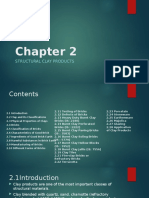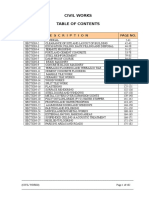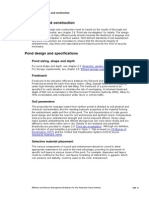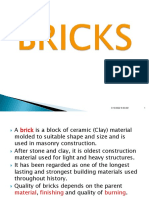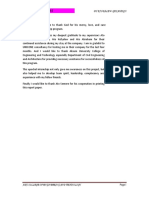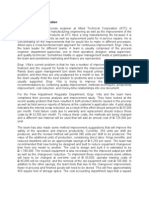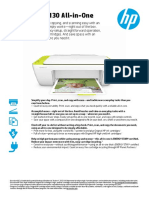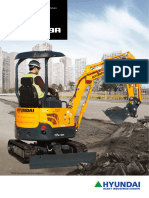Sec 2 Loading, Unloading and Staking
Sec 2 Loading, Unloading and Staking
Uploaded by
saad hussainCopyright:
Available Formats
Sec 2 Loading, Unloading and Staking
Sec 2 Loading, Unloading and Staking
Uploaded by
saad hussainCopyright
Available Formats
Share this document
Did you find this document useful?
Is this content inappropriate?
Copyright:
Available Formats
Sec 2 Loading, Unloading and Staking
Sec 2 Loading, Unloading and Staking
Uploaded by
saad hussainCopyright:
Available Formats
TABLE OF CONTENTS
2. LOADING, UNLOADING AND STACKING 1
2.1.1 SCOPE 1
2.1.2 REQUIREMENTS 1
2.1.3 STACKING AND STORAGE OF MATERIALS 1
2.1.4 BRICKS 2
2.1.5 BLOCKS 2
2.1.6 FLOOR, WALL AND ROOF TILES 2
2.1.7 AGGREGATES 2
2.1.8 STEEL 3
2.1.9 ALUMINIUM SECTIONS 3
2.1.10 DOORS, WINDOWS AND VENTILATORS 3
2.1.11 ROOFING SHEETS 4
2.1.12 GYPSUM BOARDS, PLYWOOD, FIBREBOARD, PARTICLE BOARD, BLOCK BOARD. 4
2.1.13 GLASS SHEETS 4
2.1.14 CAST IRON, GALVANIZED IRON AND NON -ASBESTOS FIBRE CEMENT PIPES AND
FITTINGS 4
2.1.15 UNPLASTICIZED PVC PIPES 5
2.1.16 BITUMEN, ROAD TAR, ASPHALT, ETC. 5
2.1.17 WATER 5
2.1.18 OIL PAINTS 5
2.1.19 SANITARY APPLIANCES 5
2.1.20 OTHER MATERIALS 6
2.2 MEASUREMENT AND PAYMENT 6
2.2.1 EARTH 6
2.2.2 OTHER MATERIALS 6
Chapter-2 [Loading, Unloading and Stacking]
2. LOADING, UNLOADING AND STACKING
2.1.1 SCOPE
Scope of work shall include the loading into trucks from specified sites or stockpiles (or
unloading as the case may be) as provided in the Contract Agreement and approved by
the Engineer-in-Charge.
2.1.2 REQUIREMENTS
a) The Contractor shall furnish, install, operate and maintain all necessary facilities for
loading/unloading trucks.
b) The Contractor shall perform all loading/unloading operations in a systematic manner
without breakages or segregation as determined by the Engineer-in-Charge and that the
cement bags and such other materials do not catch moisture and will not be contaminated
with soil or other foreign material. Contractor shall load trucks in which materials are to be
transported in such a manner as to avoid loss in transit and shall be responsible for and
make good any loss of materials lost in transit due to improper loading of mobile trucks
and other handing operations. The materials carted shall be properly stacked as specified
or directed by the Engineer-in-Charge.
2.1.3 STACKING AND STORAGE OF MATERIALS
2.1.3.1 Cement
a) Cement shall be stored at the work site in a building or a shed which is dry, leakproof and
as moisture proof as possible. The building or shed for storage should have minimum
number of windows and close fitting doors and these should be kept closed as far as
possible.
Cement shall be stored and stacked in bags and shall be kept free from the possibility of
any dampness or moisture coming in contact with them. Cement bags shall be stacked off
the floor on wooden planks in such a way as to keep about 150 mm to 200 mm clear
above the floor. The floor may comprise of lean cement concrete or two layers of dry
bricks laid on well consolidated earth. A space of 600 mm minimum shall be left all around
between the exterior walls and the stacks.
In the stacks the cement bags shall be kept close together to reduce circulation of air as
much as possible. Owing to pressure on the bottom layer of bags sometimes ‘warehouse
pack’ is developed in these bags. This can be removed easily by rolling the bags when
the cement is taken out for use. Lumbed bags, if any should be removed and disposed off.
b) The height of stack shall not be more than 10 bags to prevent the possibility of lumping up
under pressure. The width of the stack shall be not more than four bags length or 3
metres. In stacks more than 8 bags high, the cement bags shall be arranged alternately
length-wise and cross-wise so as to tie the stacks together and minimize the danger of
topping over. Cement bags shall be stacked in a manner to facilitate their removal and use
in the order in which they are received; a label showing date of receipt of cement shall be
put on each stack to know the age of cement.
Chapter-2 [Loading, Unloading and Stacking] 2-1
Chapter-2 [Loading, Unloading and Stacking]
c) Extra safety shall be exercised in coastal areas, or when it is expected to store for an
unusually long period, the stack shall be completely enclosed by a water proofing
membrane such as polyethylene, which shall close on the top of the stack. Care shall
be taken to see that the waterproofing membrane is not damaged any time during use.
2.1.4 BRICKS
Bricks shall be stacked in regular tiers as and when they are unloaded to minimize
breakage and defacement. These shall not be dumped at site.
Bricks stacks shall be placed close to the site of work so that least effort is required to
unload and transport the bricks again by loading on pallets or in barrows. Building bricks
shall be loaded or unloaded a pair at a time unless palletized. Unloading of building bricks
or handling in any other way likely to damage the corners or edges or other parts of bricks
shall not be permitted.
Bricks shall be stacked on dry firm ground. For proper inspection of quality and ease in
counting the stacks shall be 50 bricks long, 10 bricks high and not more than 4 bricks in
width, the bricks being placed on edge, two at a time along the width of the stack. Clear
distance between adjacent stacks shall not be less than 0.8 m. Bricks of each truck load
shall be put in one stack.
2.1.5 BLOCKS
Blocks shall be unloaded one at a time and stacked in regular tiers to minimize breakage
and defacement. These shall not be dumped at site. The height of the stack shall not be
more than 1.2 m. The length of the stack shall not be more than 3.0 m, as far as possible
and the width shall be of two or three blocks.
Normally blocks cured for 28 days only should be received at site. In case blocks cured
for less than 28 days are received, these shall be stacked separately. All blocks should be
water cured for 10 to 14 days and air cured for another 15 days; thus no blocks with less
than 28 days curing shall be used in building construction. The d a t e of manufacture of
the blocks shall be suitably marked on the stacks of blocks manufactured at factory or
site.
2.1.6 FLOOR, WALL AND ROOF TILES
Floor and wall roof tiles of different types, such as, cement concrete tiles (plain, coloured
and terrazzo),ceramic tiles (glazed and unglazed) and Porcelain tiles shall be stacked on
regular platform as far as possible under cover in proper layers and in tiers and they shall
not be dumped in heaps. In the stack, the tiles shall be so placed that the mould surface
of one faces that of another. Height of the stack shall not be more than one metre. During
unloading, these shall be handled carefully so as to avoid breakage.
Tiles of different quality, size and thickness shall be stacked separately to facilitate easy
removal for use in work. Ceramic tiles and clay roof tiles are generally supplied in
cartons which shall be handled with care. It is preferable to transport these at the site
on platform trolleys.
2.1.7 AGGREGATES
Aggregates shall be stored at site on a hard dry and level patch of ground. If such a
surface is not available, a platform of old corrugated iron sheets, or a floor of bricks, or a
thin layer of lean concrete shall be made so as to prevent contamination with clay, dust,
Chapter-2 [Loading, Unloading and Stacking] 2-1
Chapter-2 [Loading, Unloading and Stacking]
vegetable and other foreign matter Stacks of fine and coarse aggregates shall be kept Formatted: Font color: Red, Character scale: 103%, Not
in separate stock piles it sufficient distance from each other to prevent the material at Expanded by / Condensed by
the edges of the piles from getting intermixed. On a large job, it is desirable to construct Formatted: Font color: Red, Character scale: 103%
dividing walls to give each type of aggregates its own compartment. Fine aggregates Formatted: Font color: Red, Character scale: 103%
shall be stacked in a place where loss due to the effect of wind is minimum. Formatted: Font color: Red, Character scale: 103%, Not
Expanded by / Condensed by
2.1.8 STEEL Formatted: Font color: Red, Not Expanded by / Condensed
For each classification of steel, separate areas shall be earmarked. It is desirable that by
ends of bars and sections of each class be painted in distinct separate colours. Steel Formatted: Font color: Red, Character scale: 103%
reinforcement shall ordinarily be stored in such a way as to avoid distortion and to Formatted: Font color: Red, Not Expanded by / Condensed
prevent deterioration and corrosion. It is desirable to coat reinforcement with cement by
wash before stacking to prevent scaling and rusting. Bars of different classification,
sizes and lengths shall be stored separately to facilitate issues in such sizes and
lengths so as to minimize wastage in cutting from standard lengths. In case of long
storage, reinforcement bars shall be stacked above ground level by atleast 150 mm.
Moreover, in coastal areas or in case of long storage a coat of cement wash shall be
given to prevent scaling and rusting.
Structural steel of different classification, sizes and lengths shall be stored separately. It
shall be stored above ground level by at least 150 mm upon platforms, suitable supports
to avoid distortion of sections. In coastal areas or in case of long storage suitable
protective coating of primer paint shall be given to prevent scaling and rusting.
2.1.9 ALUMINIUM SECTIONS
Aluminium sections of different classification, sizes and lengths shall be stored
separately, on a level platform under cover. The aluminium sections shall not be pulled
or pushed from the stack nor shall be slided over each other, to protect the anodizing
layer.
2.1.10 DOORS, WINDOWS AND VENTILATORS
While unloading, shifting handling and stacking timber material, metal and plastic door
and window frames and shutters, care shall be taken that the material is not dragged
one over the other as it may cause damage to the surface of the material. The material
should be lifted and carried preferably flat avoiding damage of corners or sides. Metal
and plastic doors, windows and ventilators shall be stacked upright (on their sills) on
level ground preferably on wooden battens and shall not come in contact with dirt and
ashes.
Metal and plastic frames of doors, windows and ventilators shall be stacked upside
down. These shall not be allowed to stand for long in this manner before being fixed so
as to avoid the door frames getting out of shape and hinges being strained and shutters
drooping.
During the period of storage all metal doors, windows and ventilators shall be protected
from loose cement and mortar by suitable covering such as tarpauline. The tarpauline
shall be hung loosely on temporary framing to permit circulation of air to prevent
condensation.
All timber based frames and shutters shall be stored in a dry and clean covered space
away from any infestation and dampness. The storage shall preferably be in well
ventilated dry rooms. The frames shall be stacked one over the other in vertical stacks
with cross battens at regular distances to keep the stack vertical and straight. These
Chapter-2 [Loading, Unloading and Stacking] 2-1
Chapter-2 [Loading, Unloading and Stacking]
cross battens should be of uniform thickness and placed vertically one above the other.
The door shutters shall be stacked in the form of clean vertical stacks over the other
and at least 80 mm above ground on pallets or suitable beams or rafters. The top of
the stack shall be covered by a protecting cover and weighted down by means of
scantlings or other suitable weights. The shutter stack shall rest on hard and level
ground.
If any timber based frame or shutter becomes wet during transit, it shall be kept
separate from the undamaged material. The wet material may be dried by stacking
in shade with battens in between adjacent boards with free access of dry air
generally. Separate stacks shall be built up for each size and type of material. When
materials of different sizes and types are to be stacked in one stack due to shortage
of space, the bigger size shall be stacked in the lower portion of the stacks. Suitable
pallets or separating battens shall be kept in between the two types of material.
2.1.11 ROOFING SHEETS
Plastic sheets and Fibre glass sheets shall be stacked under a shed to a height of not
more than 0.5 m on a firm and level ground with timber or other packing beneath them.
2.1.12 GYPSUM BOARDS, PLYWOOD, FIBREBOARD, PARTICLE BOARD, BLOCK BOARD.
These boards shall be stored flat in a covered clean and dry place. Different sizes and
types of each of these boards shall be stacked separately. The board shall be stacked on
a flat platform on which a wooden frame shall be constructed with 50 mm x 25 mm battens
in such a way that it will give support to all four edges and corners of the boards with
intermediate battens placed at suitable intervals to avoid warping. Boards shall be stacked
in a solid block in a clear vertical alignment. The top sheet of each stack shall be suitably
weighed down to prevent warping wherever necessary. The boards shall be unloaded and
stacked with utmost care avoiding damage to the corners and surface. In case of
decorative plywood and decorative boards, the surfaces of which are likely to get damaged
by dragging one sheet over another it is advisable that these are lifted as far as possible in
pairs facing each other.
2.1.13 GLASS SHEETS
It is important that all glass sheets whether stored in crates or not shall be kept dry.
Suitable covered storage space shall be provided for the safe storage of the glass sheets.
In removing glass sheets from crates, great care shall be taken to avoid damages. The
glass sheets shall be lifted and stored on its long edges against a vertical wall or other
support with the first sheet so placed that its bottom edge is 25 mm from the vertical
support. The stacks shall be of not more than 25 panes and shall be supported at two
points by fillets of wood at 300 mm from each end. The whole stack shall be as close and
as upright as possible.
The glass sheets of different sizes, thickness and type shall be stacked separately. The
distance between any two stacks shall be of the order of 400 mm.
2.1.14 CAST IRON, GALVANIZED IRON AND NON -ASBESTOS FIBRE CEMENT PIPES AND
FITTINGS
The pipes shall be unloaded where they are required when the trenches are ready to
receive them. Storage shall be done on firm, level and clear ground and wedges shall be
provided at the bottom layer to keep the stack stable.
Chapter-2 [Loading, Unloading and Stacking] 2-1
Chapter-2 [Loading, Unloading and Stacking]
The stack shall be in pyramid shape or the pipes length-wise and cross-wise in alternate
layers. The pyramid stack is advisable in smaller diameter pipes for conserving space in
storing them.
The height of the stack shall not exceed 1.5 m. Each stack shall contain only pipes of
same class and size, with consignment or batch number marked on it with particulars
of suppliers wherever possible.
Cast iron detachable joints and fittings shall be stacked under cover separately from the
asbestos cement pipes and fittings
2.1.15 UNPLASTICIZED PVC PIPES
The pipe should be given adequate support at all times. Pipes should be stored on a
reasonably flat surface free from stones and sharp projections so that the pipe is
supported throughout its length. In storage, pipe racks should be avoided. Pipe should
not be stacked in large piles, especially under warm temperature conditions as the bottom
pipes may distort, thus giving rise to difficulty in jointing. Socket and spigot pipes should
be stacked in layers with sockets placed at alternate ends of the stacks to avoid lopsided
stacks.
It is recommended not to store pipe inside another pipe. Pipe should not be stored in a
stressed or bent condition or near the sources of heat. Pipes should not be stacked more
than 1.5 m high. Pipes of different sizes and classes should be stacked separately.
The ends of pipe should be protected from abrasion particularly those specially
prepared for jointing either spigot or socket solvent welded joints or shouldered for use
with couplings.
In Dry and Hot conditions, pipes should be stored in shade. In very cold weather, the
impact strength of PVC is reduced making it brittle and more care in handling shall be
exercised in wintry condition. If due to unsatisfactory storage of handling a pipe
becomes kinked, the damaged portion should be cut out completely. Kinking is likely to
occur only on very thin walled pipes.
2.1.16 BITUMEN, ROAD TAR, ASPHALT, ETC.
All types of bitumen, road tar, asphalt, etc, in drums or containers shall be stacked
vertically on their bottoms in upto 3 tiers. Leaky drums shall be segregated. Empty
drums shall be stored in pyramidal stacks neatly in rows.
2.1.17 WATER
Wherever water is to be stored for construction purposes this shall be done in proper
storage tanks to prevent any organic impurities getting mixed up with it.
2.1.18 OIL PAINTS
All containers of paints, thinners and allied materials shall preferably be stored in a
separate room on floors with sand cushions. The room shall be well-ventilated and free
from excessive heat, sparks of flame and direct rays of sun. The containers of paint
shall be kept covered or properly fitted with lid and shall not be kept open except while
using. The containers of paints have expiry date marked by the manufacturers, which
should be highlighted so as to facilitate use of paint within due period.
2.1.19 SANITARY APPLIANCES
All sanitary appliances shall be carefully stored under cover to prevent damage. When
accepting and storing appliances, advance planning shall be made regarding the
sequence of removal from the store to the assembly positions. Supporting brackets shall
be so stored as to be readily accessible for use with the appliances.
Chapter-2 [Loading, Unloading and Stacking] 2-1
Chapter-2 [Loading, Unloading and Stacking]
2.1.20 OTHER MATERIALS
Small articles like nails, screws, nuts and bolts, door and window fittings,
polishing stones, protective clothing, spare parts of machinery, linings, packing,
water supply and sanitary fittings, electrical fittings, insulation board, etc, shall be
kept in suitable and properly protected store rooms. Valuable small material such as,
copper pipes and fittings shall be kept under lock and key.
2.2 MEASUREMENT AND PAYMENT
The Employer will not be responsible for possible damage of any material, equipment or
system during loading, unloading or transportation of goods to the site of works.
The Contractor shall replace any damage goods at his own expense without additional
cost to the Employer.
Measurement and payment for loading/unloading into trucks and stacking shall be made
corresponding to CSR item as provided in the Contract Agreement and shall constitute full
compensation for performance and completion of work in all respect as specified and
approved by the Engineer-in-Charge.
Length, breadth and height of stacks shall be measured correct to a cm. The quantity shall
be worked out in cubic metre correct to two place of decimal. The volume of stacks shall
be reduced by percentages as shown against each for looseness in stacking to arrive at
the net quantity for payment. No reduction shall be made in respect of articles or materials
for which mode of payment is by length or weight or number.
2.2.1 EARTH
a) In loose stacks such as cart loads, lorry loads, etc. – 20%
b) In fills consolidated by light mechanical machinery – 10%
c) In fills consolidated by heavy mechanical machinery but not under OMC (Optimum
Moisture Content) – 5%
d) In fills consolidated by heavy mechanical machinery at OMC – Nil
e) Consolidated fills in confined situation such as under floors. etc. – Nil
2.2.2 OTHER MATERIALS
a) Manure or sludge – 8%
b) Moorum, building rubbish Lime and sand – Nil
c) Stone metal, 40 mm nominal size and above – 7.5%
d) Coarse aggregate/ stone metal below 40 mm nominal size – Nil
e) Soling stone/ Boulder 100 mm and above – 15%
f) Excavated rocks – 50%
Chapter-2 [Loading, Unloading and Stacking] 2-1
You might also like
- Shop PC 200-8Document1,009 pagesShop PC 200-8Fabian Cortes Serrano97% (109)
- Specifications: Proposed Two-Storey Residential Building SpecificationDocument5 pagesSpecifications: Proposed Two-Storey Residential Building SpecificationKarl Belleza100% (2)
- Tiling WorkDocument8 pagesTiling WorkRaden Ashkandi MuttakinNo ratings yet
- Agricultural Building and InfrastructureDocument16 pagesAgricultural Building and InfrastructureMarco Ledesma dela Cruz0% (1)
- Concrete and Cement - Building TechnologyDocument38 pagesConcrete and Cement - Building TechnologyMaimai Rea CondeNo ratings yet
- Technical Specifications PDFDocument704 pagesTechnical Specifications PDFGhulam MuhammadNo ratings yet
- 2409-Floor ScreedDocument3 pages2409-Floor ScreedRyanNo ratings yet
- St. Peter SpecsDocument5 pagesSt. Peter SpecsMickaela Kassandra Padilla ParanNo ratings yet
- Rhi Rotary Kiln 2Document40 pagesRhi Rotary Kiln 2Flor Margarita Diaz100% (2)
- Brick Water TanksDocument76 pagesBrick Water TanksAnonymous iTzCnM100% (2)
- General SpecsDocument6 pagesGeneral SpecsGlyn A. BrinquezNo ratings yet
- Thermal Moisture ProtDocument20 pagesThermal Moisture Prot200211555100% (1)
- Lecture-9 (A) Canal LiningDocument19 pagesLecture-9 (A) Canal LiningSameer SaleemNo ratings yet
- CH 2 BricksDocument19 pagesCH 2 BricksNirose ChhukanNo ratings yet
- FerroDocument129 pagesFerrosureshrakesh0% (1)
- Civil Work Specification Part 12Document10 pagesCivil Work Specification Part 12mr.xinbombayNo ratings yet
- Chapter 2 Clays and BricksDocument50 pagesChapter 2 Clays and BricksPiolo Lim AvenidoNo ratings yet
- Lecture-10 Canal LiningDocument19 pagesLecture-10 Canal LiningTamour KhalilNo ratings yet
- Concrete Block Paving - Book 2 - Design Aspects Fourth EditionDocument20 pagesConcrete Block Paving - Book 2 - Design Aspects Fourth EditionTrương Khải100% (2)
- Qcs 2010 Section 13 Part 2 Mortar and GroutDocument6 pagesQcs 2010 Section 13 Part 2 Mortar and Groutbryanpastor106No ratings yet
- Is 4082Document14 pagesIs 4082Priyanka MishraNo ratings yet
- D B Mall Projects LTD., BhopalDocument59 pagesD B Mall Projects LTD., BhopalDevendra SharmaNo ratings yet
- Gabion & Mattress Construction SpecificationDocument8 pagesGabion & Mattress Construction SpecificationAkmarn Makmur100% (2)
- Civil Work Specification Part 04Document10 pagesCivil Work Specification Part 04mr.xinbombayNo ratings yet
- How To Make Concrete Bricks and BlocksDocument8 pagesHow To Make Concrete Bricks and BlocksDesmond VlietstraNo ratings yet
- 2408-Unit MasonryDocument3 pages2408-Unit MasonryRyanNo ratings yet
- Detail Specification For Foundation WorkDocument36 pagesDetail Specification For Foundation WorkVikas ThakurNo ratings yet
- Construction Specs SampleDocument30 pagesConstruction Specs SampleChriso CincoNo ratings yet
- How To Make Concrete Bricks and Blocks 2024Document7 pagesHow To Make Concrete Bricks and Blocks 2024lamesabosharNo ratings yet
- 07 Thermal Moisture ProtDocument19 pages07 Thermal Moisture ProtAnonymous 8VJhV1eI2yNo ratings yet
- Brickwork DurabilityDocument14 pagesBrickwork DurabilityxufafruitjuiceNo ratings yet
- CivilDocument182 pagesCivilnaveed ahmedNo ratings yet
- Rosa Gres Pools Terraces Construction Rehabilitation enDocument36 pagesRosa Gres Pools Terraces Construction Rehabilitation en2fqjkrfspnNo ratings yet
- 4082-Indian Standard For Meterial StorageDocument14 pages4082-Indian Standard For Meterial StorageDeepak Garg100% (1)
- Water Proofing of Building & StructuresDocument12 pagesWater Proofing of Building & StructuresAnshumali Baruah100% (1)
- CementsDocument2 pagesCementsaddrien danielNo ratings yet
- Concrete Pavement (Highway Engineering)Document35 pagesConcrete Pavement (Highway Engineering)Joli Ann Chan TafallaNo ratings yet
- Pond Design and ConstructionDocument6 pagesPond Design and ConstructionNeil WilsnachNo ratings yet
- Thermal MositureDocument49 pagesThermal MositureSamille GarciaNo ratings yet
- Tile Works ManualDocument6 pagesTile Works Manualgau shresNo ratings yet
- MASWP301 Wall PlasteringDocument37 pagesMASWP301 Wall PlasteringKENNY -IgishinwaNo ratings yet
- Is 2248 1992Document10 pagesIs 2248 1992MukundNo ratings yet
- Lab 2 FullreportDocument12 pagesLab 2 FullreportMuhammad Zikry Bin RosliNo ratings yet
- BT ReviewerDocument4 pagesBT ReviewernanyeonghazeyoNo ratings yet
- Sang Semnr ReportDocument25 pagesSang Semnr Reportgreeshma cNo ratings yet
- Chapter - 2 - Concrete Works at Construction SiteDocument43 pagesChapter - 2 - Concrete Works at Construction Sitepritti_naa83% (6)
- Report Project Osha PDFDocument27 pagesReport Project Osha PDFSky FireNo ratings yet
- Project Report - Six Months Summer Training: Equence OF Tructure ORKDocument19 pagesProject Report - Six Months Summer Training: Equence OF Tructure ORKRajwinder Singh BansalNo ratings yet
- Concrete Construction, Curing and Skid ResistanceDocument38 pagesConcrete Construction, Curing and Skid ResistanceEarl Aguilar100% (1)
- Chapter TwoDocument12 pagesChapter Twopraisejah moyoNo ratings yet
- 6 BricksDocument59 pages6 BricksMian Afzaal 72No ratings yet
- Masonry Specs HalcrowDocument12 pagesMasonry Specs HalcrowAamir HaideriNo ratings yet
- Chapter 1 - 11 - 20Document10 pagesChapter 1 - 11 - 20MOHD ZAINUDIN JENALNo ratings yet
- Outdoor Kitchen r2 2510Document18 pagesOutdoor Kitchen r2 2510chetanjtNo ratings yet
- BricksDocument104 pagesBricksherald lesslyNo ratings yet
- CMT Lec1 PDFDocument45 pagesCMT Lec1 PDFMin Min IINo ratings yet
- Guidelines On WaterproofingDocument45 pagesGuidelines On Waterproofingdeepak925100% (1)
- Specification For Bitumen Slip Layer: 1.0 GeneralDocument4 pagesSpecification For Bitumen Slip Layer: 1.0 Generalmhamed1No ratings yet
- Specvol 2Document374 pagesSpecvol 2bolinagNo ratings yet
- Fresco Painting - Modern Methods and Techniques for Painting in Fresco and SeccoFrom EverandFresco Painting - Modern Methods and Techniques for Painting in Fresco and SeccoNo ratings yet
- 18th Presentation - Inclusive Environments - LVL 1 2020Document25 pages18th Presentation - Inclusive Environments - LVL 1 2020saad hussainNo ratings yet
- 7th Presentation - Commercial Management - Feb 2021Document59 pages7th Presentation - Commercial Management - Feb 2021saad hussainNo ratings yet
- 16th Presentation - Construction Technology - Lvl3Document52 pages16th Presentation - Construction Technology - Lvl3saad hussainNo ratings yet
- 15th Presentation - Sustainability 2019 - L1Document30 pages15th Presentation - Sustainability 2019 - L1saad hussainNo ratings yet
- Sheikh Irshad Ahmad Merit Scholarship+Amir Rasgid Merit+Akhtar Hussain Mayo+M.pervaiz Aftab Merit ScholarshipDocument5 pagesSheikh Irshad Ahmad Merit Scholarship+Amir Rasgid Merit+Akhtar Hussain Mayo+M.pervaiz Aftab Merit Scholarshipsaad hussainNo ratings yet
- LDA City ReportDocument5 pagesLDA City Reportsaad hussainNo ratings yet
- 8.01 Xpert Uraseal - Rev 02Document2 pages8.01 Xpert Uraseal - Rev 02saad hussainNo ratings yet
- Finnacial Ananlysis - Expo Quetta - 23-05-2023 - SoftDocument8 pagesFinnacial Ananlysis - Expo Quetta - 23-05-2023 - Softsaad hussainNo ratings yet
- NESPAK QuotationDocument2 pagesNESPAK Quotationsaad hussainNo ratings yet
- Iuh 0108Document1 pageIuh 0108saad hussainNo ratings yet
- Soil Re Mediation ProposalDocument10 pagesSoil Re Mediation Proposalsaad hussainNo ratings yet
- Zilver PRICELISTDocument14 pagesZilver PRICELISTsaad hussainNo ratings yet
- Subhead-8 Lift & EscalatorDocument47 pagesSubhead-8 Lift & Escalatorsaad hussainNo ratings yet
- DR Starke Shorter Presentation 20th-June-22Document164 pagesDR Starke Shorter Presentation 20th-June-22saad hussainNo ratings yet
- Ozone Hardtop: Mineral Base Dry Shake Floor Hardener For Fresh ConcreteDocument2 pagesOzone Hardtop: Mineral Base Dry Shake Floor Hardener For Fresh Concretesaad hussainNo ratings yet
- Bim & The 5D Project Cost Manager: SciencedirectDocument10 pagesBim & The 5D Project Cost Manager: Sciencedirectsaad hussainNo ratings yet
- Surveying 235 Lab ManualDocument23 pagesSurveying 235 Lab ManualcarsonNo ratings yet
- Final Report To Be Printed2Document41 pagesFinal Report To Be Printed2museNo ratings yet
- Input Bias Current Cancelation Resistors-Uticaj Bias CurrentDocument3 pagesInput Bias Current Cancelation Resistors-Uticaj Bias CurrentMilan ĐorđevicNo ratings yet
- Data Sheet 3WL1116-2CB32-1AA2: ModelDocument7 pagesData Sheet 3WL1116-2CB32-1AA2: ModelMahdi DehghankarNo ratings yet
- Allied Technical Corporation: Adonis A. Closas Joselito O. DaroyDocument4 pagesAllied Technical Corporation: Adonis A. Closas Joselito O. Daroyjod_reeNo ratings yet
- Your Paint Guide PDFDocument27 pagesYour Paint Guide PDFFaithrul RijalNo ratings yet
- Er-Diagram PreDocument8 pagesEr-Diagram PreGetachew ShambelNo ratings yet
- GSM BSC MaintenanceDocument44 pagesGSM BSC Maintenancenasiraijaz489No ratings yet
- NWSDB Annual Report 2007Document96 pagesNWSDB Annual Report 2007Civil EngineerNo ratings yet
- Solar Absorption CoolingDocument10 pagesSolar Absorption CoolingSoham MallickNo ratings yet
- MOP IndiaDocument219 pagesMOP Indiaempty87No ratings yet
- HP Deskjet 2130 BrochureDocument2 pagesHP Deskjet 2130 BrochureoonNo ratings yet
- Wifi - Faqs (Frequently Asked Questions)Document9 pagesWifi - Faqs (Frequently Asked Questions)sanjayupadhyayaNo ratings yet
- 2 Iron-Carbon Alloy SystemDocument36 pages2 Iron-Carbon Alloy SystemYour EntertainerNo ratings yet
- Improved CMOS Cascode Current MirrorDocument7 pagesImproved CMOS Cascode Current MirrorTuan NinhNo ratings yet
- Curriculum VitaeDocument4 pagesCurriculum VitaeSujay MJNo ratings yet
- 10 Question PT QuizDocument3 pages10 Question PT Quizsafeer ahmadNo ratings yet
- Systems Analysis AND DesignDocument31 pagesSystems Analysis AND DesignAbdul-Fatawu Ibn Ibrahim DoctahNo ratings yet
- BROSUR TERBARU MADYACOM 02 PC Rakitan Periperal Networking Acesoris 1Document1 pageBROSUR TERBARU MADYACOM 02 PC Rakitan Periperal Networking Acesoris 1Feni IndahNo ratings yet
- Boyle's LawDocument4 pagesBoyle's LawEn CsakNo ratings yet
- Grundfosliterature 146158Document16 pagesGrundfosliterature 146158AddeNifiraNo ratings yet
- Azipod & CRP Azipod PropulsionDocument6 pagesAzipod & CRP Azipod PropulsionAkarshan SoodNo ratings yet
- Smart Pad System: For Press BrakesDocument9 pagesSmart Pad System: For Press BrakesasliNo ratings yet
- Query Access ServiceDocument154 pagesQuery Access Servicesharmapradeep2014No ratings yet
- c2 - Static Load Case EditorDocument22 pagesc2 - Static Load Case EditorEsapermana RiyanNo ratings yet
- Q4-Check List For Panel Concrete Pour Card For DWDocument1 pageQ4-Check List For Panel Concrete Pour Card For DWAmjad PathanNo ratings yet
- Allied International Group 2014Document44 pagesAllied International Group 2014Enoch TwumasiNo ratings yet
- HYUNDAI En-R17z-9a-BrochureDocument9 pagesHYUNDAI En-R17z-9a-BrochureisprengelNo ratings yet
- User Manual Jamicon 3vaav eDocument15 pagesUser Manual Jamicon 3vaav ematwan29No ratings yet
















